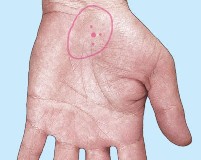How does SU JOK heal (more detailed)
The human body is a complex mechanism where all the parts work in constant close interrelation. To function correctly they continuously interchange information. In every part of the body without interruption comes in information about all other parts and at the same time information about each part's condition is emitted. This interchange of information as well as the storage of the received information is carried out by the so-called correspondence systems.
The correspondence systems are informative-power producing projections of the organism located on all independent parts of the body. They look like reduced images of the human body, so deformed that to build in the form of the appropriate body part. Correspondence systems are built in the ears, head, feet, hands, internal organs, tongue, eyebrows and all other independent parts of the body, even in each cell .
As each correspondence system is a reduced image of the organism, all the organs, all parts of the body are represented in it. The zones, the areas of the correspondence systems, which correspond to the particular body organs are called correspondence zones. Each organ and part of the body have their own correspondence zone in all correspondence systems. For example the stomach has zones of correspondence in the systems of correspondence, located on the ears, eyes, feet and in all other correspondence systems.



The correspondence systems are in continuous informative interchange. They contain full information about the organism. Save for the fact they have information about the human organism, they actively stimulate its state of health. The mechanism for this stimulation is as following:
When an organ is diseased, in all other correspondence systems a signal concerning this is received. The correspondence systems react and in them, in the correspondence zone tissue of the diseased organ one or more miniature spheric formations are formed. When pressed they are painful and are subjectively felt as pain points.


If the kidney gets diseased , pain points appear in its correspondence zones, located on the ears, hands, feet, tongue, fingers and all other independent parts of the body. The same happens with a disease of the stomach, eyes, liver and every other organ or part of the body.
In everyday life man continuously stimulates, accidentally and chaotically one or another correspondence system and the pain points, which have appeared there as a result of a disease. When you put a hat, you press part of the correspondence zones, located on the head. When you walk you massage the correspondence zones on the feet. When you work you stimulate the correspondence zones on the hands etc.
As a result of this stimulation the pain points in the correspondence zones generate healing impulses directed to the diseased organ. In this way healing impulses flow from different parts of the body, from different correspondence systems to the diseased organ. They activate complex regulating mechanisms, which fight against the disease.
The healing impulses existing in consequence of the human everyday activity, are formed accidentally and chaotically. They are sufficient for the preventive keeping fit when there are some slight deviations in the state of health. But these impulses may not exist by sedentary way of living or may be not enough with more severe diseases. Then the disease gets worse. Therefore to heal ourselves when we are seriously ill, it is necessary to create powerful enough healing impulses through intentional and directed stimulation of the pain points in some of the correspondence systems.
This question emerges immediately - which of the correspondence systems are most efficient and can be used most successfully for that purpose? Which of them include the organism reserves most effectively? The experience gained till now indicated that these are the correspondence systems located on independent parts of the body, which have the strongest resemblance to the human body and create healing impulses most often. Such independent parts are hands and feet. They have amazing structural resemblance, similarity to the human body structure. In addition they get most often into contact with the environment thus creating healing impulses most often. Nature wisely took care the most often created impulses to be the most powerful and effective. Because of that the healing impulses generated in the correspondence systems located on the hands and feet are far more powerful and effective than the impulses generated in the most of the other correspondence systems.
Su-Jok therapy is entirely created on the basis of the correspondence systems located on the hands and feet. It consists of two levels. The first level is easy to use by people without medical education and includes several healing correspondence systems:
- Main correspondence system;
- Correspondence system "Insect".
These two correspondence systems are suitable and sufficient for unaided practice. The second, the high level of Su-Jok is a healing method based on metaphysical ground. It is more complicated and for its learning greater efforts are needed.
Copyrighted text: copying and quoting is permitted if its source is indicated (on the internet - with a hyperlink).
<<<Back